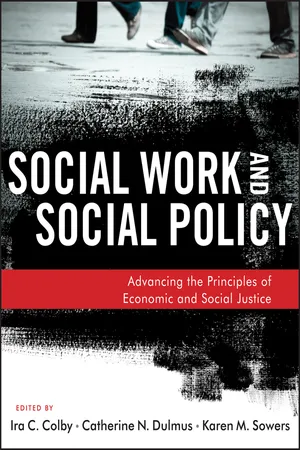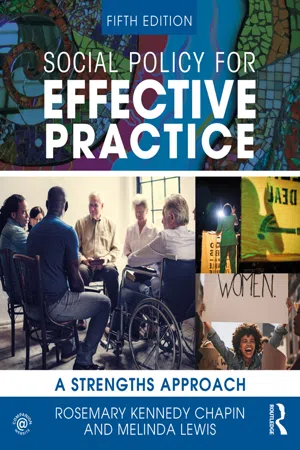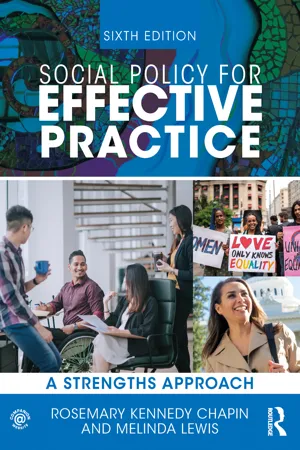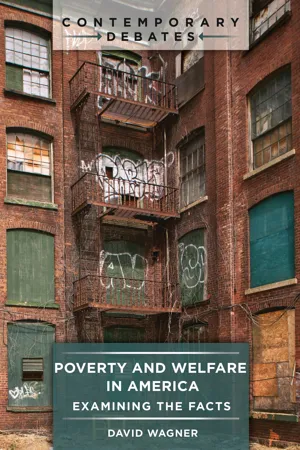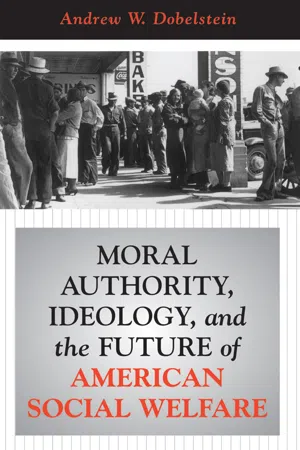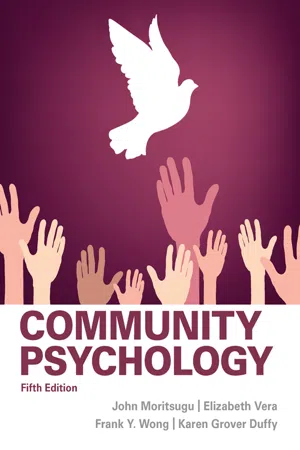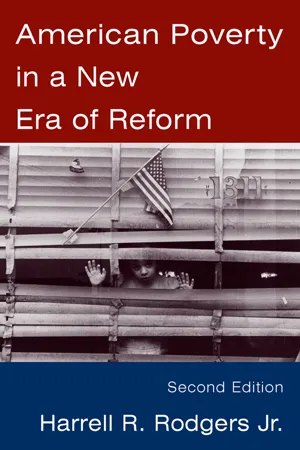History
Social Welfare Programs
Social welfare programs refer to government initiatives designed to provide assistance and support to individuals and families in need. These programs aim to address poverty, unemployment, healthcare, and other social issues by offering financial aid, healthcare services, and other forms of support. Throughout history, social welfare programs have evolved to meet changing societal needs and economic conditions.
Written by Perlego with AI-assistance
Related key terms
Related key terms
1 of 4
Related key terms
1 of 3
7 Key excerpts on "Social Welfare Programs"
- eBook - ePub
Social Work and Social Policy
Advancing the Principles of Economic and Social Justice
- Ira C. Colby, Catherine N. Dulmus, Karen M. Sowers(Authors)
- 2012(Publication Date)
- Wiley(Publisher)
- Collective interventions to meet certain needs of the individual and/or to serve the wider interests of society (Titmuss, 1959, p. 42)
- A system of social services and institutions, designed to aid individuals and groups to attain satisfying standards of life and health, and personal social relationships that permit them to develop their full capacities and promote their well-being in harmony with the needs of their families and community (Friedlander, 1955, p. 140)
- A nation's system of programs, benefits, and services that help people meet those social, economic, educational, and health needs that are fundamental to the maintenance of society (Barker, 1995, p. 221)
These definitions reflect a specific philosophy or view of welfare. Close examination reveals three common themes:- Social welfare includes a variety of programs and services that result in specific, targeted client benefit.
- Social welfare, as a system of programs and services, is designed to address the needs of people. The needs are wide-ranging; on the one hand, they may be all-encompassing, including economic and social well-being, health, education, and overall quality of life; conversely, needs may be narrowly targeted, focused on one issue.
- The primary outcome of social welfare policy is to improve the well-being of individuals, groups, and communities. Helping those people address their specific needs benefits society at large.
The Relationship Between Justice Theory and Social Welfare Policy
All welfare policies are extensions of justice theories and reflect particular principles on the human condition. David Miller (p. 1, 2005) poses the central question related to justice and welfare: - eBook - ePub
Social Policy for Effective Practice
A Strengths Approach
- Rosemary Kennedy Chapin, Melinda Lewis(Authors)
- 2020(Publication Date)
- Routledge(Publisher)
Our current social welfare policies are the product of decades or, in some cases, centuries of debate and struggle. Religious and spiritual teachings introduced thousands of years ago continue to shape people’s orientations to policy responses and the parameters that drive current debates, including the idea that some individuals are more deserving of assistance than others. Your study of this historical context will be more useful for your practice if you link what you learn about history to the policies that shape social work today. Further, knowing that the policies that form the backdrop of our current social welfare system were often hotly contested during their development underscores the potential for change. To engage in effective policy practice, it is crucial to understand factors that influenced social policy in the past and those likely to influence policy in the future.THE GENESIS OF SOCIAL WELFARE POLICYSocial work clients often live in poverty. Further, anti-poverty policy is a potent example of the relationship between beliefs about the origins of problems and the nature of responses to them. For these reasons, this chapter begins with an exploration of practices in pre-industrial societies that gave rise to current programs for people who have low incomes. The major religions and spiritual practices of these societies require their adherents to care for people who are poor. Later, these individual obligations gave rise to increasingly sophisticated institutions and systems of relief. At the same time, powerful members of the ruling elite were careful to maintain the social and economic barriers that oppressed poor people and protected their own privilege. Thus, the social welfare structures that evolved to address poverty also served as a means of social control. This dynamic continues today.Religious and Spiritual TraditionsWe begin our discussion of the early historical mandates that shaped social policy by examining selected religious traditions from around the world. Throughout history, these religious traditions and systems often developed in parallel in different communities around the globe; therefore, they are presented here without intention to construct a chronology or, certainly, a hierarchy. Further, as dynamic movements, these religious and spiritual traditions have evolved over the centuries, influencing each other and responding to their social contexts. We encourage you to examine early religious writings for additional examples of attitudes and practices related to social welfare and to consider how they relate to current social policy. - eBook - ePub
Social Policy for Effective Practice
A Strengths Approach
- Rosemary Kennedy Chapin, Melinda Lewis(Authors)
- 2023(Publication Date)
- Routledge(Publisher)
Current social welfare policies are the product of decades or, in some cases, centuries of debate and struggle. Religious and spiritual teachings introduced thousands of years ago, including the idea that some individuals are more deserving of assistance than others, continue to shape policy responses. Policy precedents and the social movements that contest them reverberate in our debates over approaches. Your study of these historical contexts will be more useful for your practice if you link what you learn about history to the policies that shape contemporary social work. Further, knowing that policies that form the backdrop of our current social welfare system were often fiercely challenged during their development underscores the potential for change today. To engage in effective policy practice, it is crucial to understand factors that influenced social policy in the past and those likely to influence policy in the future.THE GENESIS OF SOCIAL WELFARE POLICY
Social work clients often live in poverty. Even when poverty is not the central concern that brings a client to seek social work assistance, it often exacerbates other challenges and/or limits the options for addressing the principal issue. As described in Chapters 4 and 8 , addressing poverty, either as the central concern or as a corollary to other efforts, often requires resources, the distribution and redistribution of which are crucial signals of societal values. Further, anti-poverty policy is a potent example of the relationship between beliefs about the origins of problems and the nature of responses to them. For these reasons, this chapter begins with an exploration of practices in pre-industrial societies that gave rise to current programs to address financial needs, and also with some discussion of how these traditions viewed other social issues that confronted society, such as disability.Religious and Spiritual Traditions
We begin our discussion of the early historical mandates that shaped social policy by examining selected religious traditions from around the world. Throughout history, these religious traditions and systems often developed in parallel in different communities around the globe; therefore, they are presented here without intention to construct a chronology or, certainly, a hierarchy. Further, as dynamic movements, these traditions continue to evolve and influence each other. We encourage you to examine early religious writings for additional examples of attitudes and practices related to social welfare and to consider how they relate to current social policy. We also must recognize the extent to which historical accounts often silence the contributions of some groups, particularly women and people of color (Wright, Carr, & Akin, 2021 - eBook - ePub
Poverty and Welfare in America
Examining the Facts
- David Wagner(Author)
- 2019(Publication Date)
- ABC-CLIO(Publisher)
4 What Are “Welfare” and “Social Welfare”?In order to understand the issues and controversies around the efforts to alleviate poverty and related social problems, it is important to discuss what the concept of social welfare is, and how that contrasts with the layperson’s often pejorative view of the word “welfare” in the United States. Also, we need to identify the several ways society has of aiding people, which generally includes only a limited number of strategies.Social welfare is defined by experts and international bodies in a very broad way. Social welfare experts Joel Blau and Mimi Abramowitz (2004), for example, define it asan organized system of laws, programs, and benefits, and services which aid individuals and groups to attain satisfying standards of life, health, and relationships needed to develop their full capacities . . . they address basic human needs. Those needs include income security, health, education, nutrition, employment, housing, a sense of belonging, and opportunity to participate in society.Note how broad this definition is. Social welfare around the world is far more than about income support, although it certainly includes that, and far more than issues involving poverty, although it includes that as well. It is about whether or not you have health care, and whether help is from government or charity or the private sector, about counseling services, about aid to the aged, about laws and policies regarding domestic violence and sexual violence, the issues of alcohol and drug use, the programs for disability, efforts to help people with housing, with homelessness, with recreation, education, and job training, to name only some examples. Social welfare crosses lines of income and class; it involves all sectors of society including the public, nonprofit sector and the for-profit sector. The largest Social Welfare Programs are usually those for many millions of people such as the United States’ Social Security and Medicare programs. - Andrew W. Dobelstein(Author)
- 2018(Publication Date)
- Routledge(Publisher)
5 The Evolution of America’s Present-Day Welfare Policies and Programs Since 1935 America’s social welfare system has grown beyond both the values and the governmental structures that originally supported it. Programs that once had clear-cut objectives have become atomized into fragments that no longer fit with the original welfare purposes or the objectives of America’s other institutions. In other words, present social welfare is out of harmony with America. For example, unemployment compensation, originally designed to provide a transition from forced unemployment into a new job situation, often prolongs unemployment for persons who are reluctant to take jobs that may be beneath their skill levels. Understanding contemporary social welfare and its development allows insight into present-day welfare dilemmas that goes beyond the usual rhetoric of welfare reform debates. This chapter shows how the original Social Security Act programs have gradually been transformed into today’s public welfare programs. Throughout the changes of the past sixty years, the philosophy about who should provide welfare has shifted back and forth. At first the federal role in welfare was to be only temporary, in contrast with the insurance programs. Yet federal administrations continued to recommend federal welfare expansion. The Social Security Act established the architecture for America’s welfare system, and this original design (discussed in Chapter 4) had a limited welfare scope. These architectural features of American welfare establish a federal activity restricted by constitutional authority, with accompanying intergovernmental limitations, incapable of pursuing broad-based national welfare objectives. Most federal welfare initiatives take place through federal grants-in-aid to states. Even though states must reshape their welfare laws to conform to grant-in-aid requirements, fundamental legislative authority for most welfare activity continues to rest in state statutes- eBook - ePub
Community Psychology
Fifth Edition
- John Moritsugu, Elizabeth Vera, Frank Y Wong, Karen Grover Duffy(Authors)
- 2015(Publication Date)
- Routledge(Publisher)
Social welfare or ideas and activities to promote social good have a long history in Western society. Until modern times, two major forms of social welfare were charity/philanthropy (private assistance) and public welfare (public assistance). During the 19th century (around the time of the Industrial Revolution), two other forms of social welfare were born: social insurance (public assistance derived from taxation) and social service (public nonmaterial human services derived from taxation). To receive social welfare, people must demonstrate their need, usually in the form of a low standard of living or poor economic means.It is generally believed (i.e., stereotyped) that recipients of social welfare are lazy, despite the fact that they might genuinely need such assistance. On the other hand, donors to community services are perceived to be honorable people, although research indicates that willingness to help is often a function of environmental factors (e.g., people are more generous during religious seasons).Five groups that interface regularly with human services in U.S. communities are maltreated children and their families, survivors of domestic violence, pregnant teens, the elderly, and the homeless.Teen parents and others—such as people who themselves were abused children—are predicted to be at risk for maltreating a child. Providing social support, parenting and prenatal education, and links between the parents and services in the community can sometimes prevent child abuse. The Nurse-Family Partnership program has proven to be particularly successful in reducing child maltreatment among first-time, at-risk teen mothers and has been disseminated nationwide.Women who are being victimized by intimate partner violence are at risk for enormous physical and psychological injuries, including death. Those who are able to escape such situations often face an uphill battle as they attempt to gain emotional and economic independence for themselves and their children. Programs to address this problem include prevention aimed at changing gender role beliefs, improving interpersonal skills, and attempting to provide psychological and career services for women who seek safety in domestic violence shelters. - eBook - ePub
- Harrell R. Rodgers(Author)
- 2015(Publication Date)
- Routledge(Publisher)
Figure 1.1 ). The American public philosophy stresses freedom and opportunity over equality (Bobo and Smith, 1994; Feagin, 1975; Shapiro et al., 1987). Americans believe that everyone should be given an opportunity to succeed, that opportunity may not be truly equal but that it is bountiful, and that economic failure generally reflects personal failings. Although public surveys show that Americans are generally sympathetic toward the poor, they are not comfortable with policies that financially support healthy unemployed adults unless the support is transitional. The public believes that anyone can suffer a financial setback, but that with a little help there are ample opportunities for people to recover if they work hard. The public fears that welfare that is too generous, or poorly designed, may undermine core American values by rewarding, supporting, and encouraging indolence and even immoral behavior (Mead, 1986, 1992; Bobo and Smith, 1994). Thus, the public supports long-term aid only for those who cannot care for themselves, and temporary aid to help the able-bodied become settled in the workforce. The American philosophy can be thought of as a belief in “rugged individualism” and personal responsibility, and faith in the power of the economic market. Emphasis is placed on keeping the economy healthy, vigorous, and competitive to create opportunity, while insisting that all who can support themselves through the market do so. This philosophy has shaped the establishment and evolution of the American welfare system. At any point in which welfare seemed to evolve into a system that conflicted with this philosophy, public officials have struggled to reform the system.The Historical Context
The first federal assistant program was a modest program to aid widowed mothers passed in 1911 (Allard, 2004; Skocpol et al., 1993). Decades after the other major Western industrial nations had developed and begun to refine their welfare programs, the United States laid the foundation for a national welfare system with the passage of the Social Security Act of 1935. This act was passed in response to the Great Depression (Katz, 1986; Piven and Cloward, 1971). The economic collapse brought about by the depression was so massive that by 1933 one-fourth of the nation’s adult males were unemployed, millions of families were losing their homes, and thousands stood in bread lines each day. Millions of those who suffered from the economic crisis had formerly been viable members of America’s middle class (Rodgers, 1979, 43–72).When Franklin D. Roosevelt became president in 1933, he was reticent about using public funds directly to assist those individuals devastated by the economic crisis. Reluctantly, under the Federal Emergency Relief Administration, President Roosevelt sent billions of dollars to the states to help them aid their citizens (Leuchtenburg, 1963). The states handed out most of this money in the form of cash relief and public service jobs, many of which were considered “make-work.” Roosevelt became alarmed when the relief rolls continued to grow. In 1935 some 20 million Americans were receiving support. In his State of the Union address in 1935, Roosevelt warned Congress that relief undermined the character of the public and the strength of the nation:
Index pages curate the most relevant extracts from our library of academic textbooks. They’ve been created using an in-house natural language model (NLM), each adding context and meaning to key research topics.
Explore more topic indexes
Explore more topic indexes
1 of 6
Explore more topic indexes
1 of 4
